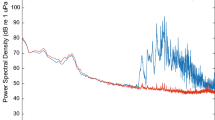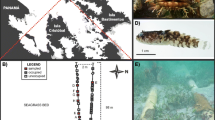Abstract
The cichlids of Lake Malawi are one of the world’s most species rich and phenotypically diverse groups of extant vertebrates. The extraordinary variability of this group’s color patterns, reproductive behaviors, and trophic morphologies are well documented. More recently, an additional axis of phenotypic diversity has been identified. Lake Malawi cichlids have been shown to use species-specific acoustic communication in both aggressive and reproductive encounters. However, documentation of acoustic signals used by this group is limited to a small number of taxa observed within the confines of the laboratory. This study examines the acoustic signals produced by six species spanning four genera of rock-dwelling cichlids recorded in their natural habitat, the shallow waters surrounding Thumbi West Island, Lake Malawi. Four acoustic parameters were quantified and compared between species: trill duration, number of pulses per trill, pulse duration, and pulse period. Using these characteristics, sympatric species within the genus Maylandia were easily distinguished. Furthermore, a comparison of this data to previously published acoustic data reveals possible geographic dialects within species.


Similar content being viewed by others
References
Albertson RC, Markert JA, Danley PD, Kocher TD (1999) Phylogeny of a rapidly evolving clade: The cichlid fishes of lake malawi, east africa. Proceedings of the National Academy of Sciences of the United States of America 96:5107–5110
Almeida OG, Miranda A, Frade P, Hubbard PC, Barata EN, Canário AVM (2005) Urine as a social signal in the Mozambique Tilapia (Oreochromis mossambicus). Chem Senses 30(Suppl 1):1309–1310
Amorim MCP (2006) Diversity of sound production in fish. In: Ladich F, Collin SP, Moller P, Kapoor BG (eds) Communication in fishes, vol. 1. Science Publishers, Enfield, pp 71–104
Amorim MCP, Fonseca PJ, Almeida VC (2003) Sound production during courtship and spawning of Oreochromis mossambicus male-female and male-male interactions. J Fish Biol 62(3):658–672
Amorim MCP, Knight ME, Stratoudakis Y, Turner GF (2004) Differences in sounds made by courting males of three closely related Lake Malawi cichlid species. J Fish Biol 65:1358–1371
Amorim MCP, Simões JM, Fonseca PJ, Turner GF (2008) Species differences in courtship acoustic signals among five Lake Malawi cichlid species (Pseudotropheus spp.). J Fish Biol 72:1355–1368
Barata EN, Hubbard PC, Almeida OG, Miranda A, Canário AVM (2007) Male urine signals rank in the Mozambique tilapia (Oreochromis mossambicus). BMC Biol 5:1–11
Bender N, Heg-Bachar Z, Oliveira RF, Canário AVM, Taborsky M (2008) Hormonal control of brood care and social status in a cichlid with brood care helpers. Physiol Behav 94:349–358
Blais J, Plenderleith M, Rico C, Taylor MI, Seehausen O, van Oosterhout C, Turner G (2009) Assortative mating among Lake Malawi cichlid fish populations is not simply predictable from male nuptial color. BMC Evol Biol 9:1–12
Carleton K (2009) Cichlid fish visual systems: mechanisms of spectral tuning. Integr Zool 4:75–86
Carleton KL, Spady TC, Kocher TD (2006) Visual communication in East African cichlid fishes: diversity in a phylogenetic context. In: Ladich F, Collin SP, Moller P, Kapoor BG (eds) Communication in fishes, vol. 1. Science Publishers, Enfield, pp 485–515
Clarif RA, Waack AM, Strickman LM (2008) Raven v1.3. The Cornell Lab of Ornithology. Ithaca, NY. www.birds.cornell.edu/raven
Clement TS, Grens KE, Fernald RD (2004) Female affiliative preference depends on reproductive state in the African cichlid fish, Astatotilapia burtoni. Behav Ecol 16:83–88
Cole TB, Stacey NE (2006) Olfactory responses to steroids in an African mouth-brooding cichlid, Haplochromis burtoni (Günter). J Fish Biol 68:661–680
Danley PD (2001) The ecological behavioral, and genetic factors influencing the diversification of Lake Malawi’s rock-dwelling cichlids. Ph.D. Dissertation, University of New Hampshire
Danley PD, Kocher TD (2001) Speciation in rapidly diverging systems: lessons from Lake Malawi. Mol Ecol 10:1075–1086
Genner MJ, Turner GF (2005) The mbuna cichlids of Lake Malawi: a model for rapid speciation and adaptive radiation. Fish Fish 6:1–34
Giaquinto PC, Volpato GL (1997) Chemical communication, aggression, and conspecific recognition in the fish Nile Tilapia. Physiol Behav 62:1333–1338
Hert E (1989) The function of egg-spots in an African mouth-boarding cichlid fish. Anim Behav 37:726–732
Jordan R, Kellogg KA, Juanes F, Stauffer, JR Jr (2003) Evaluation of female mate choice cues in a group of Lake Malawi mbuna (Cichlidae). Copeia 181–186
Jordan R, Mellor D, Wilt L, Gershenson D, Howe D (2010) Male interactions in a group of Malawi cichlids. Ethol Ecol Evol 22:359–364
Kidd MR, Danley PD, Kocher TD (2006) A direct assay of female choice in cichlid fishes: all the eggs in one basket. J Fish Biol 68:373–384
Knight ME, Turner GF (1999) Reproductive isolation among closely related Lake Malawi cichlids: can males recognize conspecific females by visual cues? Anim Behav 58:761–768
Kocher TD (2004) Adaptive evolution and explosive speciation: the cichlid fish model. Nature Rev Genet 5:288–298
Lanzing WJR (1974) Sound production in the cichlid Tilapia mossambica Peters. J Fish Biol 6:341–347
Lobel PS (1992) Sounds produced by spawning fishes. Environ Biol Fish 33:351–358
Lobel PS (1998) Possible species specific courtship sounds by two sympatric cichlid fishes in Lake Malawi, Africa. Environ Biol Fish 52:443–452
Lobel PS (2001) Acoustic behavior of cichlid fishes. J Aquaricult Aquat Sci 9:89–108
Longrie N, Fine ML, Parmentier E (2008) Innate sound production in the cichlid Oreochromis niloticus. J Zool 275:413–417
Longrie N, Van Wassenbergh S, Vandewalle P, Mauguit Q, Parmentier E (2009) Potential mechanism of sound production in Oreochromis niloticus (Cichlidae). J Exp Biol 212:3395–3402
Miranda A, Almeida OG, Hubbard PC, Barata EN, Canário AVM (2005) Olfactory discrimination of female reproductive status by male tilapia (Oreochromis mossambicus). J Exp Biol 208:2037–2043
Nelissen MHJ (1975) Sound production by Simochromis diagramma (Günther) (Pisces, Cichlidae). Acta Zool Pathol Antverp 61:19–24
Nelissen MHJ (1977) Sound production by Haplochromis burtoni (Günther) and Tropheus moorii Boulenger (Pisces, Cichlidae). Ann Soc R Zool Belg 106:155–166
Nelissen MHJ (1978) Sound production by some Tanganyikan cichlid fishes and a hypothesis for the evolution of their communication mechanisms. Behaviour 64:137–147
Plenderleith M, van Oosterhout C, Robinson RL, Turner GF (2005) Female preference for conspecific males based on olfactory cues in a Lake Malawi cichlid fish. Biol Lett 1:411–414
Rice AN, Lobel PS (2002) Enzyme activities of pharyngeal jaw musculature in the cichlid Tramitichromis intermedius: implications for sound production in cichlid fishes. J Exp Biol 205:3519–3523
Rice AA, Lobel PS (2004) The pharyngeal jaw apparatus of the Cichlidae and Pomacentridae: function in feeding and sound production. Rev Fish Biol Fish 13:433–444
Ripley JL, Lobel PS (2004) Correlation of acoustic and visual signals in the cichlid fish, Tramitichromis intermedius. Environ Biol Fish 71:389–394
Robinson RR, Fernald RD, Stacey NE (1998) The olfactory system of a cichlid fish responds to steroidal compounds. J Fish Biol 53:226–229
Simões JM, Duarte I, Fonseca PJ, Turner GF, Amorim MCP (2006) Acoustic behaviour in Malawian cichlids (Pseudotropheus, Cichlidae): potential cues for species recognition and intraspecific communication. Razprave IV, razreda SAZU, XLVII-3, 229–236
Simões JM, Duarte IG, Fonseca PJ, Turner GF, Amorim MCP (2008a) Courtship and agonistic sounds by the cichlid fish Pseudotropheus zebra. J Acoust Soc Am 124:1332–1338
Simões JM, Fonseca PJ, Turner GF, Amorim MCP (2008b) African cichlid Pseudotropheus ssp. males moan to female during foreplay. J Fish Biol 72:2689–2694
Smith AR (2007) Is acoustic communication a candidate signal for sexual selection in Malawian Cichlids? M.A. Thesis, Bowling Green State University
Smith AR, van Staaden MJ (2009) The association of visual and acoustic courtship behaviors in African cichlid fishes. Mar Freshwat Behav Physiol 42:211–216
Streelman JT, Danley PD (2003) The stages of vertebrate evolutionary radiation. Trends Ecol Evol 18:126–131
Van Oppen MJ, Turner GF, Rico C, Robinson RL, Deutsch JC, Genner MJ, Hewitt GM (1998) Assortative mating among rock-dwelling cichlid fishes supports high estimates of species richness from Lake Malawi. Mol Ecol 7:991–1001
Venesky MD, Andraso GM, Ropski SJ (2005) Behavior of male kenyi cichlids, pseudotropheus lombardoi, in response to visual and olfactory cues from females. BIOS 76:77–83
Acknowledgement
We thank Adam Smith and Moira van Staaden for further information on the populations they observed. Emily Rapstine provided assistance in digitizing the recordings. Arthur Popper generously provided the hydrophone and amplifier. Thomas Kocher and Karen Carleton provided PDD with the opportunity to record at Thumbi West Island. We are grateful to the University of Malawi and officials at Lake Malawi National Park for providing the facilities and permits necessary to conduct this work. We also want to thank Aimee Howe, other members of the Danley Lab, and two anonymous reviewers for their comments on this manuscript.
Author information
Authors and Affiliations
Corresponding author
Rights and permissions
About this article
Cite this article
Danley, P.D., Husemann, M. & Chetta, J. Acoustic diversity in Lake Malawi’s rock-dwelling cichlids. Environ Biol Fish 93, 23–30 (2012). https://doi.org/10.1007/s10641-011-9886-z
Received:
Accepted:
Published:
Issue Date:
DOI: https://doi.org/10.1007/s10641-011-9886-z




